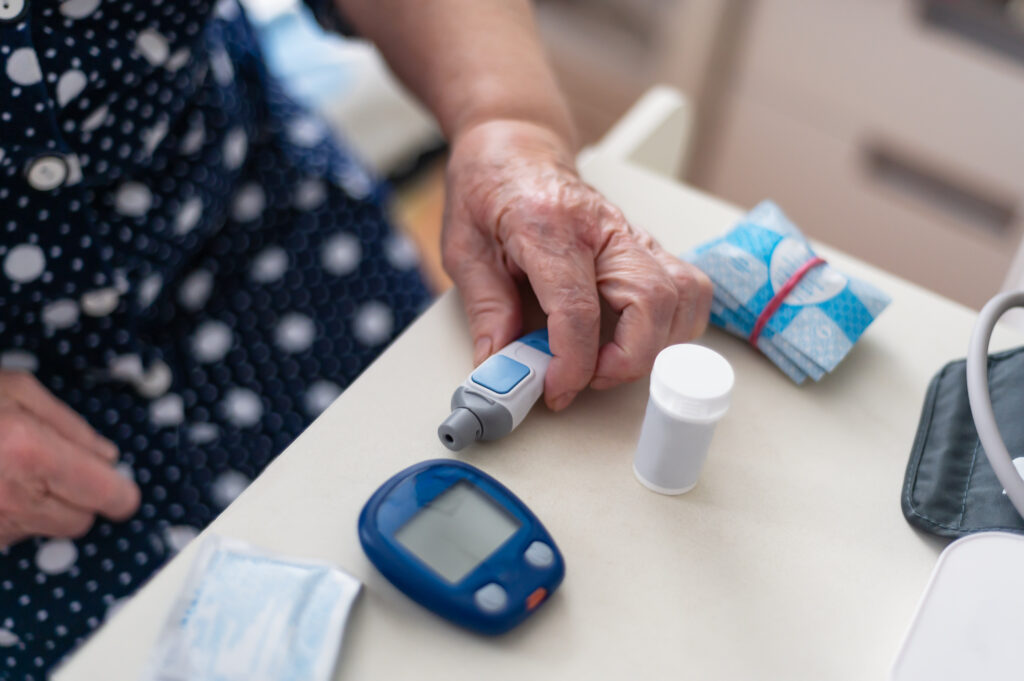Taking care of your health starts with understanding how diabetes works, what puts you at risk, and how to prevent or manage it. Maybe you’re looking to stay healthy and avoid complications. Or you might be supporting a loved one. Either way, knowing the basics is the first step.

What is diabetes?
Diabetes is a chronic condition that affects how your body turns food into energy. Normally, your body breaks down food into sugar (also known as glucose). The sugar is then released into the bloodstream. When blood sugar levels increase, your body uses a hormone called insulin, which helps turn that sugar into energy. But with diabetes, your body either doesn’t make enough insulin or can’t use it the right way, leading to high blood sugar levels.1
Over time, unmanaged diabetes can lead to complications for your eyes, heart, blood vessels, nerves and kidneys.2 But with the right care and lifestyle choices, people with diabetes can take control of their health.
How common is it?
Diabetes is more common than you might think. Millions of people in the U.S. have it but are unaware of their condition.
38.4 million
people in the U.S. have diabetes.3
22.8%
of adults with diabetes are undiagnosed.3
18.6%
increase in type 2 diabetes diagnoses from 2012 to 20224
17%
higher rates of type 1 diabetes in 2020–2021, compared to 2016–20195
Did you know?
Some groups of people, including Hispanic/Latino, African American/Black and South Asian populations, are at a higher risk. This makes regular check-ups and healthy lifestyle choices even more important. Knowing about your health and taking charge can make a big difference.

What are the types of diabetes?
There are different types of diabetes, and each one needs different care.
Type 1 diabetes
With type 1 diabetes, the body’s immune system attacks the cells in the pancreas that make insulin. This means that too much sugar stays in the blood. Type 1 diabetes is often diagnosed in childhood or young adulthood. Insulin is taken to control blood sugar, but what you eat and how much exercise you get can also help keep blood sugar steady. It’s important to check blood sugar levels throughout the day.6
Type 2 diabetes
This is the most common type of diabetes. With type 2 diabetes, the body doesn’t use insulin the right way, which leads to high blood sugar levels. The risk of developing type 2 diabetes increases with age, but children with certain risk factors may also be diagnosed. It can often be handled with lifestyle changes, medication or both.7
Gestational diabetes
This is a temporary form of diabetes that some people develop during pregnancy. It most often goes away after childbirth. Gestational diabetes increases the risk of getting type 2 diabetes later in life. An oral glucose tolerance test is used to diagnose the condition, typically between the 24th and 28th weeks of pregnancy. Keeping a balanced food plan, exercising, and taking diabetes medicine may all be part of treatment.8
What about prediabetes?
Prediabetes means your blood sugar levels are higher than normal but not high enough to be diagnosed as type 2 diabetes.9 It’s a warning sign. The good news is that taking medicine or making health changes—such as eating well and moving more—can help stop or delay diabetes.
Your culture and diabetes
Diabetes affects people from all backgrounds, but people from Hispanic/Latino, African American/Black and South Asian communities are at a higher risk. That’s why awareness, routine check-ups and proactive care are so important.
Talking about your family health history and checking in with your doctor can help you stay ahead of risks and make the best choices for your well-being.
In the U.S., 11.7% of Hispanics/Latino adults have diabetes, compared with 6.9% of non-Hispanic white adults.3 Genetics, diet and access to care all play a role. But regular screenings, lifestyle changes and a doctor you trust can help lower your risk.
In the U.S., 12.1% of African American/Black people have diabetes, compared with 6.9% non-Hispanic whites.3 They’re also more likely to have health complications from the disease than non-Hispanic whites. Genetics, diet and access to care all play a role. But regular screenings, lifestyle changes and a doctor you trust can help lower your risk.
While weight is a major factor in developing diabetes, South Asian people are at a higher risk compared with other groups of people, even if they are not overweight. A diabetes screening test is recommended if body mass index (BMI) is 23 or greater. Genetics, diet and access to care all play a role. But regular screenings, lifestyle changes and a doctor you trust can help lower your risk.10
Find a doctor who’s right for you
Learn More about lifestyle choices that affect diabetes

Learn common symptoms.
It’s important to listen to your body and its changes. Some diabetes symptoms can be mild, while others go unnoticed. And sometimes, there are no signs at all. If you are having any of these symptoms, schedule an appointment with your doctor:11
- Extreme fatigue
- Numb or tingling hands or feet
- More frequent infections
- Nausea, vomiting and stomach pain
- Drastic, unexplained weight loss
- Excessive thirst and/or nonstop hunger
- Cuts or bruises that are slow to heal
- Frequent urination
- Blurry vision
Managing diabetes comes with challenges, but small changes can make a big difference. See how you can take control of your health.
Know your risk of prediabetes.†
Health care providers can diagnose prediabetes and diabetes through blood tests. Having prediabetes increases the chance of getting type 2 diabetes. Testing is a helpful way to track your health.
Take this quick prediabetes risk test,12 and then be sure to discuss next steps with your doctor.
†Cigna Healthcare is not collecting or using the data entered. This is intended to help provide personalized recommendations.
Your mental health matters too.
Living with diabetes isn’t always easy, and it can be a lot at first. Remember that your mental well-being is just as important as your physical health. Learn how to care for both.
Find the right care for you.
When it comes to preventing or taking care of your diabetes, finding a health care provider you trust can make a big difference. Search for a doctor by location, gender, language preference and more.
Resources and tools
Ready to make the next step in your health journey? Your future needs you, and a healthier tomorrow starts with the actions you take now. Explore these tools to maintain your health, prevent illness and lower health care costs.
Use personalized tools
Access health information anytime, anywhere.
Download the myCigna App:

This information is for educational purposes only. It is not medical advice. Always consult your doctor for appropriate examinations, treatment, testing and care recommendations. Any third-party content is the responsibility of such third party. Cigna Healthcare® does not endorse or guarantee the accuracy of any third-party content and is not responsible for such content. Your access to and use of this content is at your sole risk.
Cigna Healthcare products and services are provided exclusively by or through operating subsidiaries of The Cigna Group.
*Diagnoses for both type 1 and type 2 diabetes are on the rise.
- Cigna Healthcare. “Type 1 Diabetes.” Knowledge Center. Last reviewed April 30, 2024. https://www.cigna.com/knowledge-center/hw/medical-topics/type-1-diabetes-hw34303
- Cigna Healthcare. “Type 2 Diabetes.” Knowledge Center. Last reviewed April 30, 2024. https://www.cigna.com/knowledge-center/hw/medical-topics/type-2-diabetes-hw135189
- Centers for Disease Control and Prevention (CDC). “National Diabetes Statistics Report.” May 15, 2024. https://www.cdc.gov/diabetes/php/data-research/index.html
- Neupane S, Florkowski WJ, Dhakal U & Dhakal C. “Regional disparities in type 2 diabetes prevalence and associated risk factors in the United States.” Diabetes, Obesity and Metabolism. July 18, 2024. https://doi.org/10.1111/dom.15797
- Lomte TS. “Diabetes incidence significantly increased among youth during COVID-19 pandemic.” News-Medical.Net. September 25, 2023. https://www.news-medical.net/news/20230925/Diabetes-incidence-significantly-increased-among-youth-during-COVID-19-pandemic.aspx
- Cigna Healthcare. “Type 1 Diabetes.” Knowledge Center. Last reviewed April 30, 2024. https://www.cigna.com/knowledge-center/hw/medical-topics/type-1-diabetes-hw34303
- Cigna Healthcare. “Type 2 Diabetes.” Knowledge Center. Last reviewed April 30, 2024. https://www.cigna.com/knowledge-center/hw/medical-topics/type-2-diabetes-hw135189
- Cigna Healthcare. “Gestational Diabetes.” Knowledge Center. Last reviewed April 30, 2024. https://www.cigna.com/knowledge-center/hw/medical-topics/gestational-diabetes-hw197466
- Cigna Healthcare. “Prediabetes.” Knowledge Center. Last reviewed April 30, 2024. https://www.cigna.com/knowledge-center/hw/medical-topics/prediabetes-uz1410
- Cigna Healthcare. “South Asian Health Disparities.” April 2022. https://www.cigna.com/health-care-providers/resources/south-asian-health-disparities
- CDC. “Symptoms of Diabetes.” May 15, 2024. https://www.cdc.gov/diabetes/signs-symptoms/index.html
- CDC. Prediabetes Risk Test. Last reviewed September 22, 2022. https://www.cdc.gov/prediabetes/pdf/Prediabetes-Risk-Test-Final.pdf